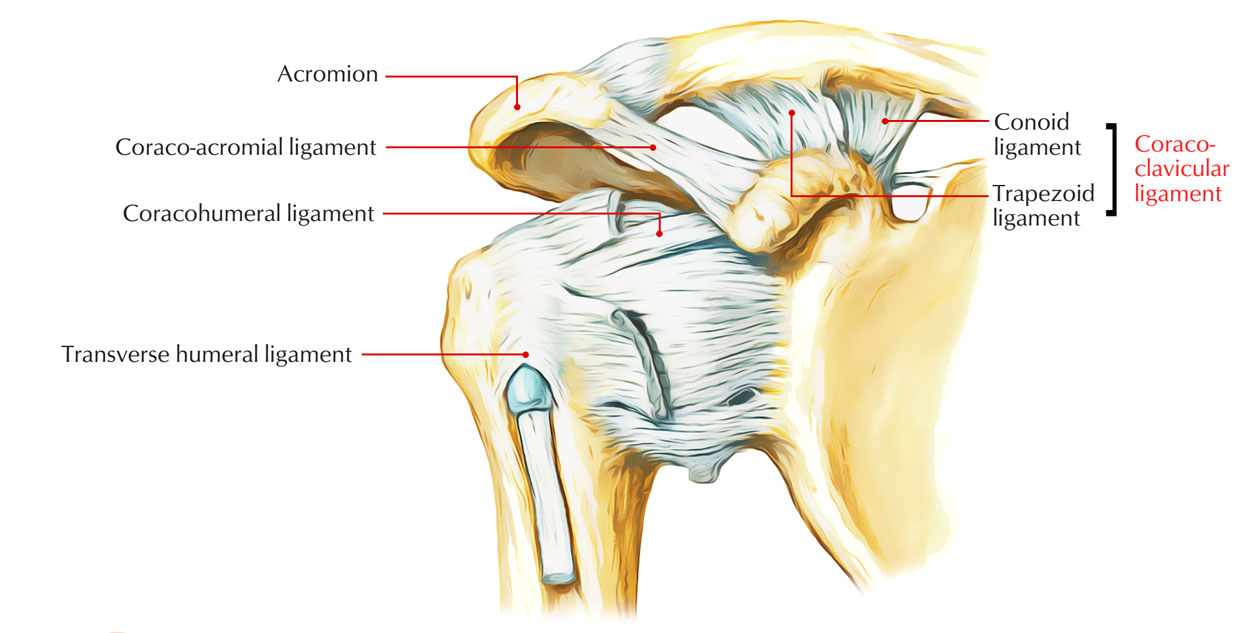The coracoclavicular ligament is in fact two ligaments, the trapezoid and the conoid. The trapezoid and the conoid ligaments have identical dimensional, viscoelastic behavioral and structural characteristics, regardless of their morphologic differences. It plays an important function in sustaining the integrity of the joint however lies little far from the joint itself.
Structure
The coracoclavicular ligament includes two parts:
- Conoid.
- Trapezoid, which are combined posteriorly and often separated by a bursa.
- The conoid ligament is an inverted cone-shaped fibrous band. Base is connected to the conoid tubercle on the inferior surface of the clavicle and the apex is attached to the root of the coracoid process just lateral to the scapular notch.
- The trapezoid ligament stretches from upper surface of the coracoid process to the trapezoid line on the inferior surface of lateral end of the clavicle and is a horizontal fibrous band.
- Suspending the weight of the scapula and upper limb from clavicle is largely responsiblility of the coracoclavicular ligament.
- The coracoclavicular ligament is the strongest ligament of the upper limb.

Coracoclavicular Ligament
Connection
- Both of these ligaments connect to the superior element of the angular region of the coracoid process.
- Via a more anterior and lateral position that starts at the angle of the coracoid, ends posterior to the pectoralis minor tendon attachment and courses in the direction of its tip, the trapezoid ligament is oriented toward the clavicle in a superior, anterior, and moderately lateral direction to attach at the trapezoid line on the inferior clavicle.
- The conoid ligament expands in area as it runs superiorly and moderately medially toward its point of insertion, the conoid tubercle, from a more posterior and medial site on the angle.
- At the curve’s apex the conoid tubercle can be recognized on the posteroinferior clavicle, just posteriorand medial to the most medial element of the trapezoid line, now the lateral one third and medial two thirds of the clavicle join to create the posterior curve of the clavicle.
- On the lateral element of the more horizontal part of the coracoid is the connection of the coracoacromial ligament distal to the angle. It joins onto nearly the entire width of the acromion process at its anteroinferior edge.
Functions
- The coracoclavicular ligament assists to link scapulohumeral activity and scapulothoracic activity, by the way of its attachments to the clavicle and scapula, and their respective connection to the axial skeleton and upper body.
- These two ligaments create a much stronger union of the clavicle to the scapula than the acromioclavicular ligaments.
- This ensures that the clavicle and scapula will move simultaneously, signifying the limits of the natural excursion of the acromioclavicular joint, as the acromioclavicular ligaments reach maximum stress.
- In the presence of an intact coracoclavicular ligament, the functional strength of the acromioclavicular joint increases.
- Thus, the effective suspension of the upper limb from the torso via the sternoclavicular joint and supporting musculature is ensured.
- The function of the acromioclavicular and coracoclavicular ligaments as anterior-to-posterior and superior-to-inferior stabilizers, respectively, displacement resistance of the lateral clavicle is significantly more complex.
Action
- The primary restraint comes from the conoid portion of the coracoclavicular ligament.
- At all loads, the primary restraint to posterior clavicular displacement is provided by the acromioclavicular ligaments.
- Whereas the conoid ligament gives resistance to the larger loads, For superior displacements, once again with smaller loads, the acromioclavicular ligaments give restraint.
- Nonetheless, with posterior rotation, the acromioclavicular ligaments and both coracoclavicular ligaments appear to contribute similarly. The conoid ligament also gives the primary restraint to anterior clavicular rotation.
- the conoid ligament mainly resists the larger loads and afterwards both the acromioclavicular and conoid ligaments provide combined resistance to small loads in superior clavicular rotation,.
- Eventually, the trapezoid part of the coracoclavicular ligament gives the primary resistance, with axial joint compression.
Palpation and Examination
The examiner supports the clavicle while pulling the inferior angle of the scapula away from the chest wall. The trapezoid portion of the ligament might be evaluated from the same position. The stability of the conoid portion of the coracoclavicular ligament might be evaluated by positioning the patient in a side lying position on the untouched side with the hand resting against the lower back. The inspector supports the clavicle and pulls the medial border of the scapula far from the chest wall. Pain in either case in the space of the ligament (anteriorly under the clavicle between the outer one-third and inner two-thirds) constitutes a favorable test.

 (56 votes, average: 4.86 out of 5)
(56 votes, average: 4.86 out of 5)